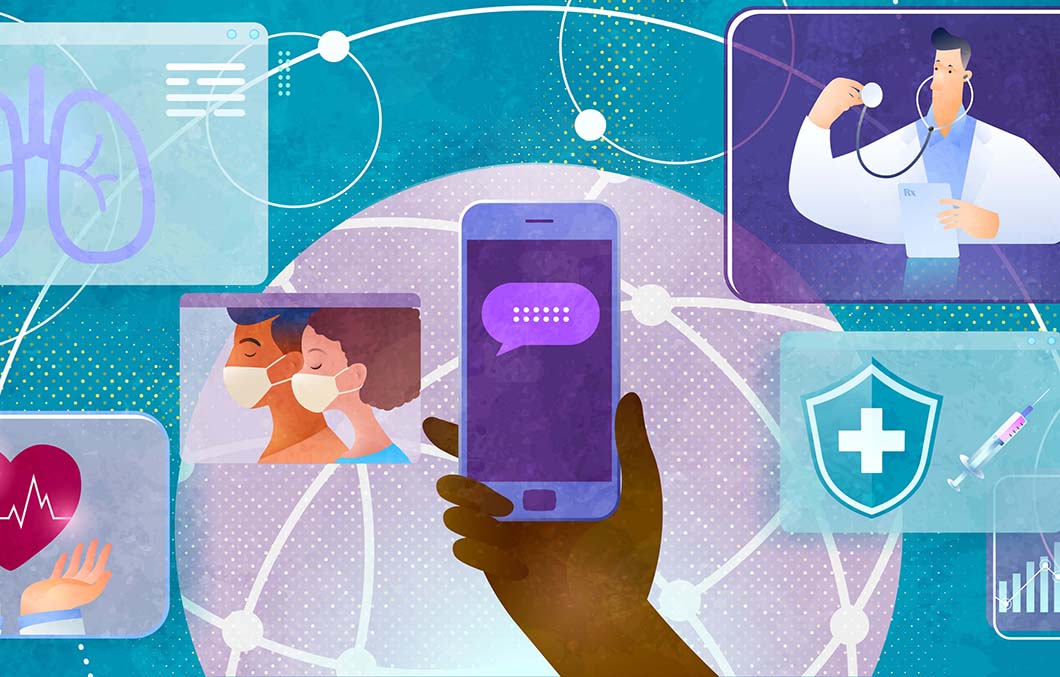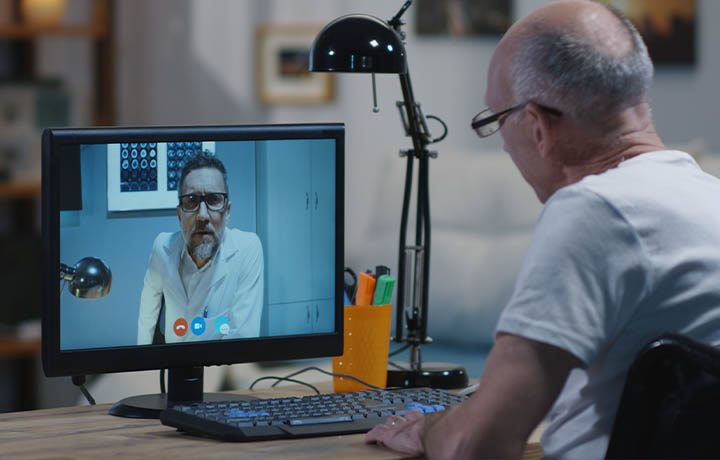Article
Thriving during pandemic
By Lia Novotny | September 16, 2020

Recently, athenahealth spoke with a panel of innovative practice leaders to discuss how they changed during COVID-19, what they focused on, and how they made the pivot quickly. Here are edited excerpts from the conversation.
Taking COVID-19 precautions reassured patients
Dale Owen, M.D., CEO of Tryon Medical Partners: There’s a huge fear factor. And it’s not just the elderly, it’s not just the folks who are infirm in some way. It’s all age groups and across the entire community. We had to make them feel more secure, which is why we moved all of our potential sick patients out of the office and created satellite clinics.
Brent Asplin, M.D., president Village Medical: First, we also moved suspected COVID cases out of the clinic workflow, to telehealth. And we use pulse oximetry in the patient’s home so that we can monitor them and determine if they need to go to a hospital emergency department. Second, we adopted a universal PPE, universal masks, a welcome center at the front of the clinic, temperature checks, etc., to reduce asymptomatic spread. Once we did that, our care workers who needed to sit out because of exposure went down dramatically.
Scott Moore, M.D., president, Green Tree Pediatrics: COVID is going to continue to be a disruptor for quite a while. If you look at the list of the criteria for possible COVID, it's really about anything that would bring a kid into a pediatric office to begin with. So that's super easy in August and early September. It's going to be a lot harder come November. You are going to have to schedule sick visits for mild illness that you otherwise wouldn't have seen a year ago, but you're bringing them in so you can do testing because of this new thing we call COVID drastically changing how we do things.
Owen: We want the patient to feel empowered, that they can choose any modality that works – phone, virtual visit, in-person. We literally have people drive by under a parking deck and have people who go out there and meet them. And we do injections there, and we’re drawing blood, giving flu shots, and everything else there. And we have involved employers, some very large Fortune 500 companies, to jump into COVID testing. We quickly set up an interface with a particular lab for saliva testing, and athena provided help with this really quickly. It’s just being ready for whatever is going to happen.
Rapidly deploying virtual care created new connection pathways
Scott Moore: It was pretty clear right out of the gate that we were going to have to open up different ways for patients to be seen. We had been using telemedicine for probably about a year-and-a-half prior to this — it seemed like a great tool that we didn't quite know how to use. We used it mainly for mental health visits. But it went from probably 3 percent of what we were doing to about 80 percent of what we were doing.
Asplin: Yes, I think we've had some of the same experiences. We peaked at 82 percent of all encounters at telehealth; we're now down into the upper 30s. I think one of the messages is, although telehealth is a tool that clearly is going to have much broader use than it did previously, it's not a substitute for seeing your physician in person and getting those ancillary tests and closing quality gaps.
James Meyers, M.D., director of clinical informatics from the Greater Lawrence Family Health Center: Lawrence is a city where health literacy is low, where people who are working can't work remotely, and social distancing is literally impossible because of crowded conditions. So we had to change a lot in a couple of days. We went from doing all in-person visits to doing over 1,000 telehealth visits a day. And then we scrambled to keep up with the billing and the systems, and everything else that went with it.
Owen: We were also somewhere around 1 to 2 percent telehealth use. So within two weeks, we had everybody – literally 100 percent – certified and able to perform and operate telehealth completely. And we got out in front of it with our patients and we told them what we thought might happen, and that they were going to need to be ready to use telehealth. The day after the emergency declaration was made we were down 35%. The following day we were only down 10% because we had everybody ready and going full bore on telehealth.
Asplin: We’ve used telehealth not just for provider encounters, but we're also doing audio/video encounters with our care management team. Which, if you think about the highest-risk patients, one of the things that they've been suffering with the most during this pandemic quite honestly is loneliness. Our MAs or care managers took the opportunity to reach out and just spend some time with people.
Meyers: As Dr. Moore said, telehealth has been around as a tool in our pocket that we couldn't use because we didn't have a reason to and it wasn't reimbursed at all in primary care, really. And suddenly we can. So we have a large population of people who have transportation difficulties — it creates huge no-show rate problems and inefficiencies in the clinic. And we have many chronic disease patients, diabetics, who could easily be seen every other visit, or even two out of three visits over telehealth. It's definitely here to stay. I think it's going to change a lot. And risk stratification is a big part of it as well.
Focusing on robust outreach, particularly for high-risk patients, built trust
Asplin: One of the first things we did in the pivot at the beginning of this pandemic was utilize not only data from athena, but other data we have to do a risk stratification in addition to our normal proprietary Medicare risk assessment. And we had all hands on deck to mobilize and reach out to these people, ask them what support they needed, if they needed food delivered, other things to keep them out of risk. And that was really facilitated by the platform.
Misha Moore, Ph.D., executive director, Green Tree Pediatrics: Pre-COVID we thought we did a really good job of getting patients in for well visits and immunizations. We used the automated campaigns, we ran our reports, we had a lot of systems in place to make sure we had our appointment reminders in place. During COVID we needed to do just as well, if not better. And so, we really stood by the mantra that we cannot sit back and wait for the phone to ring. We bumped it up a level, running reports by diagnosis, looking for last-seen, looking for upcoming appointments, trying to catch anybody who might fall through the cracks, using all the tools we have in athena. There is nothing more powerful than a phone call that says, the doctor looked at your chart and really wants to talk to you, really wants to see you.
Myers: We greatly increased the size of our call center and outsourced some of it. And really scripted things so that our people know that if a patient calls and is sick, unless they're ill enough we think they need to be hospitalized, we don't necessarily bring them in. And we let our staff know so that they can set the patient expectations around that. I think the key is consistency, setting the expectation consistently across the board with all the patients who come in. People are confused. People are scared. We have to be able to reassure them. I reach out to my individual patients who need to see me in person. I do that almost every day.
Misha Moore: So that outreach is important. And Facebook helps, and Instagram helps, and the website helps. I think our portal adoption rate is over 80%, all that outreach was important, and is important. But none of that is going to work unless the trust is there.
Meyers: Going forward, I think we are going to see some really exciting changes. Changes to technology and changes to access are going to be so intertwined. So breaking into telehealth, adding phone and video and texting, it’s an opportunity for EMR vendors to bring these things into the product. Imagine if I wanted to communicate to a patient and that's all I had to think about. I could text the patient directly from the EMR. And in the background, the system would document for me. What we have to do is really tie the model together. It'll improve access to care. It'll improve quality of care. It'll improve consistency of care.
Rethinking business models and staffing protected financial outcomes
Owen: Our business model had to change tremendously just within routine business of seeing patients in the office. If you have 15, 20 percent or more of the patients in telehealth and not seeing those people in the office, you don't really need as many staff, you can make it lean.
Asplin: I think the most important thing we've done during this whole pandemic is really increase the frequency of our communication, both internally with our team and then extending that to our patients. Make a decision. But be honest and say, “You know what, next week it may be different.” I think that’s been one of the most important things.
Misha Moore: We are focused on reaching out to patients to really get that volume back. Twenty percent of our revenue is valued-based, but we are still in a fee-for-service world, and those visits are important. So we do need our patients, whether it's our virtual door or a real door, we do need to get them across it.
Asplin: I think the pandemic has really demonstrated the power of a financially at-risk reimbursement model. Now, it has to be tied to health outcomes, it has to be tied to great experience and clinical quality, but if all those things are true, a business model that is at risk, just frees care teams up. It allows them to make the best decisions thinking about a whole panel of patients and worry less about the top-line revenue. That’s been one of the strengths of the response that we've had to date. We definitely think that's the future.






